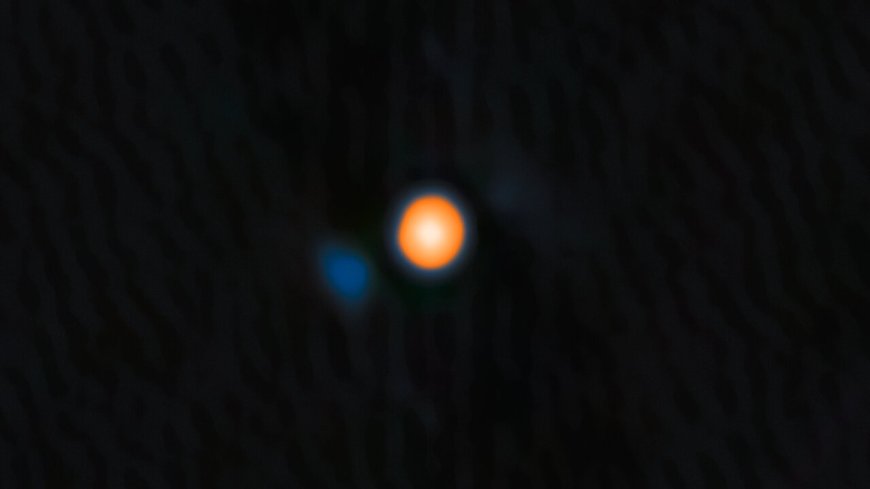Astronomers Confirm Betelgeuse Has a Secret Companion Star Named 'Her Bracelet'
Astronomers have confirmed that the red supergiant star Betelgeuse has a companion star, now known as 'Her Bracelet'. The newly discovered star, nicknamed 'Siwarha', orbits Betelgeuse and explains the star's regular brightening and dimming pattern every six years.

Betelgeuse (in orange) has a newly found companion star, faintly visible to the left in dark blue. Betelgeuse's brightness varies in a predictable, six-year pattern, which has puzzled astronomers for centuries; now, astronomers say the companion is likely responsible.
The red supergiant Betelgeuse likely has a companion star, astronomers have confirmed. Long theorized to share an orbit with Betelgeuse — an extremely bright star that may go supernova in the next few thousand years — a sun-size companion star has finally appeared in unique observations taken with the Gemini North telescope high on Hawaii's Mauna Kea.
If confirmed, the newly found star would account for a longstanding mystery: why Betelgeuse has a regular pattern of brightening and dimming about every six years.
To seek out the companion, astronomers opened and shut the telescope imager in just 14 milliseconds. \"That was the only way we could not have Betelgeuse saturate our detectors,\" lead author Steve Howell, a senior research scientist at NASA Ames Research Center, told LiveScience.
The new study, published July 24 in the Astrophysical Journal Letters, builds upon the work of two modeling studies in 2024 that suggested Betelgeuse had a companion. But the fresh observations, though compelling, are still not a slam-dunk and will require confirmation.
\"It's barely detected there,\" Howell acknowledged, saying the observation was at the very limits of Gemini's capabilities. But what astronomers saw \"matches all the other things in the models, exactly.\"
That brief glimpse of the supposed companion shows it is 1.5 times the mass of the sun, and early in its life: The star is so young that it has not started burning hydrogen in its core. The companion orbits Betelgeuse once every six years, at about four times the distance from Earth to the sun.
But the young star is literally touching Betelgeuse as it flies around; Betelgeuse is 700 times the size of our sun, according to NASA, so the companion traces a path through the ginormous star's outer atmosphere despite orbiting relatively far away.
The uneasy proximity won't last for long. \"It's going to be subsumed into Betelgeuse, so it's not a happy ending for the companion,\" Howell said, noting this could happen within just 10,000 years. \"The question might be, 'Will Betelgeuse explode in a supernova before the star spirals in?'.\"
Howell says the team is now requesting telescope time to observe Antares, another bright star with variable luminosity that might be hiding a companion. Bright stars like Antares and Betelgeuse, he said have been understudied by professionals as they produce absurd glare in the meters-wide telescopes astronomers use. Howell added the ultra-fast exposure technique that his team came up with to study Betelgeuse may be useful for studying bright stars more generally.
In the meantime, his team found time to nickname Betelgeuse's apparent teammate. The name \"Betelgeuse\" can be translated from Arabic, NASA stated, as \"the hand of al-Jawza',\" which refers to a female character in an Arabian legend. Howell's team thus named the companion \"Siwarha\", or \"her bracelet.\"
According to the source: Live Science.
What's Your Reaction?
 Like
0
Like
0
 Dislike
0
Dislike
0
 Love
0
Love
0
 Funny
0
Funny
0
 Angry
0
Angry
0
 Sad
0
Sad
0
 Wow
0
Wow
0


























































































































































































